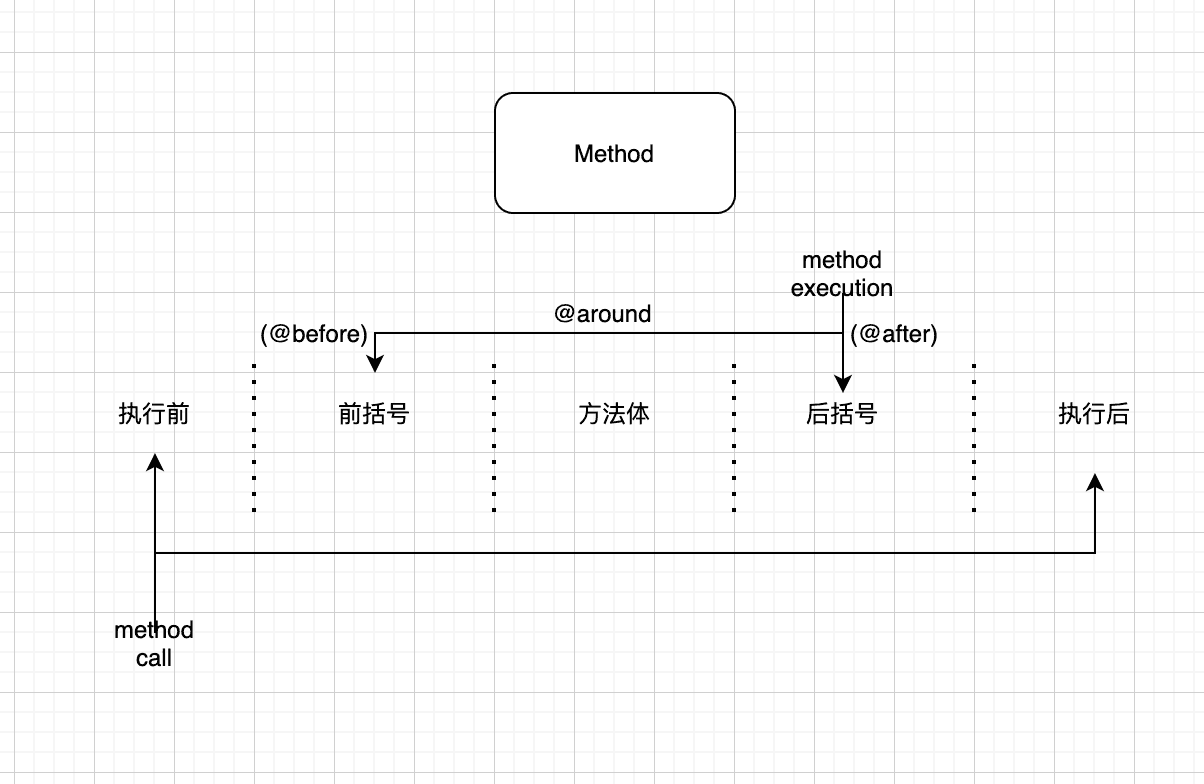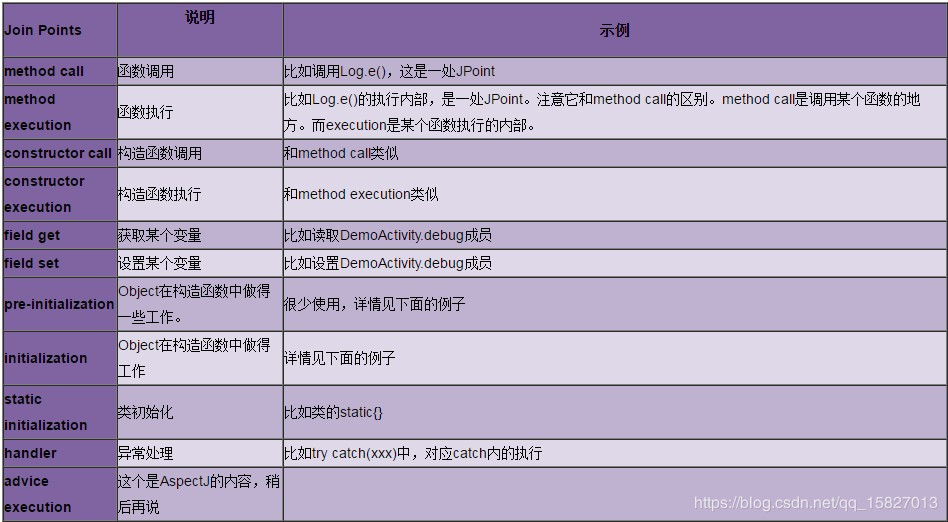1. 简介
Aspect Oriented Programming(AOP)面向切面编程是目前比较流行的一种编程方式。android端引入比较插件麻烦,可以采用
https://github.com/HujiangTechnology/gradle_plugin_android_aspectjx
2. 原理
通过预编译方式和运行期动态代理实现不修改源代码,就给程序动态统一添加功能,直白点说就是插桩。

简单示例
@Aspect
class InheritAspect {
private companion object {
private const val TAG = "InheritAspect"
private const val ON_CREATE_EXECUTION = "execution(void *..*Activity.onCreate(..))"
}
@Pointcut(ON_CREATE_EXECUTION)
fun onCreateExecution() {
}
@Before("onCreateExecution()")
fun beforeOnCreateExecution(joinPoint: JoinPoint) {
Log.i(TAG,"onCreate start")
}
}
反编译后
//源代码
protected void onCreate(@Nullable Bundle var1) {
super.onCreate(var1);
}
//运行后
protected void onCreate(@Nullable Bundle var1) {
JoinPoint var2 = Factory.makeJP(ajc$tjp_7, this, this, var1);
//拿到InheritAspect的单例对象
InheritAspect.aspectOf().beforeOnCreateExecution(var2);
super.onCreate(var1);
}
3. 使用
1.支持的连接点(JoinPoint) --> 程序中可以插入代码的地方

2. 表达式
{注解}{修饰符}<返回值>{类}<方法名><方法参数>
{}为可选项
a> 可以通过使用&&、||、!操作符进行逻辑关系组合
b> JoinPoint提供this属性,代表当前AOP代理对象
call(* action(..))&&this(AspectJActivity)
相当于插入了
if(xxx instanceof AspectJActivity){//执行插入代码段}
c> 连接点JoinPoint提供了args,用来约束实参的类型
execution(* a(Context+))&&args(Activity)
d>还有target、within 不常用
- 注解支持
(1)@this/@target/@within/@args分别对应上面的几个表达式
(2)@annotation, 可以通过自定义or系统的注解来过滤,例如
@Retention(RetentionPolicy.RUNTIME)
@Target(ElementType.METHOD)
public @interface LoginFilter {
...
}
@LoginFilter()
public UserInfo getUserInfo() {
...
}
@PointCut(@annotation(com.richard.kaishustory.aop.LoginFilter))
public void onNeedLoginPoint(){}
@Around("onNeedLoginPoint")
public void onNeedLoginHook(final ProceedingJoinPoint) {
...
}
- JoinPoint类参数说明
/**
* this:AOP代理对象
* target:目标对象
* args:参数类型列表
* signature.methodName:连接点的方法名
* signature.declaringTypeName:连接点的方法属于的类型(编译时类型)
* sourceLocation.withinType:连接点声明类(编译时类型)
* sourceLocation.fileName:调用连接点方法的源码文件
* sourceLocation.line:调用连接点方法的源码的行数
*/
fun showJoinPoint(joinPoint: JoinPoint, tag: String = "JoinPoint") {
val thisObj = "this:${joinPoint.`this`?.javaClass?.name ?: "no"}\n"
val targetObj = "target:${joinPoint.target?.javaClass?.name ?: "no"}\n"
val args = "args:${joinPoint.args?.map { it?.javaClass?.name ?: "no" } ?: "no args"}\n"
val methodName = "methodName:${joinPoint.signature.name}\n"
val declareType = "declareType:${joinPoint.signature.declaringTypeName}\n"
val withinType = "withinType:${joinPoint.sourceLocation.withinType?.name ?: "no within type"}\n"
val sourceLocation = "sourceLocation:${joinPoint.sourceLocation.let { "${it.fileName}-${it.line}" }}\n"
}
ProceedingJoinPoint是JoinPoint的子类,多出来的是proceed()方法,用于执行切入点的源代码,该类型也是运行中实际创建的JoinPoint类型,before和after执行proceed没有意义,所以一般不用;而around一般用这个类型,用于执行源代码
- 运行时参数
以上是插入代码方式,但是这还不够,因为我们很有可能在插入的代码中,去操作实际参数,甚至是this、target对象等,而我们现在的参数只有JoinPoint,这显然不够,需要拿到一些参数对象,举个栗子:
@Pointcut(value = "call(* *(..))&&this(activity)&&target(cat)&&args(value)", argNames = "activity,cat,value")
fun onPointCutCall(activity: AspectJActivity, cat: Cat, value: String) {
}
@Before(value = "onPointCutCall(activity,cat,value)", argNames = "activity,cat,value")
fun beforePointCutCall(joinPoint: JoinPoint, activity: AspectJActivity, cat: Cat, value: String) {
//do with params
}
4. 注意事项
a> 在类型匹配时,Number+,代表的是Number及其子类型,比如Double,Integer,但是不包括double,int,这些原始类型需要单独声明,比如int *(…)
b> 对于同一个切点,如果同时声明了@After和@Before,则不能声明@Around,会报错-编译器不能决定插入顺序;但是声明其中之一和@Around是可以的
c> 在匹配表达式中,如果父类的方法作为了切点,那么其子类重写的相应方法也会被作为切点,如果只想子类作为切点, 可以使用
execution(* com.richard.base.BaseActivity+.onCreate(**))
但是如果子类方法调用了super,则会两个都会切入
d> aspectj 容易与其他第三方库冲突,可以使用include只对需要内容插桩, or exclue 排除插桩三方库
aspectjx {
//排除
exclude 'android.support'
//或者包括内容
include 'com.richard.domain'
}


